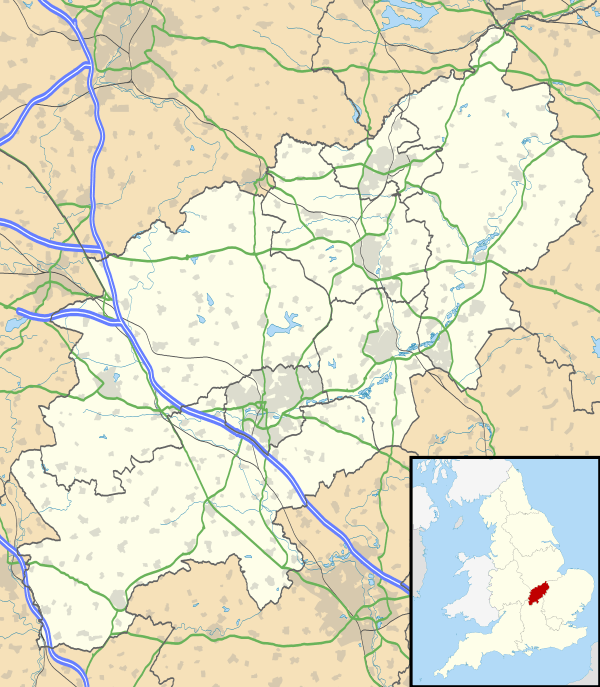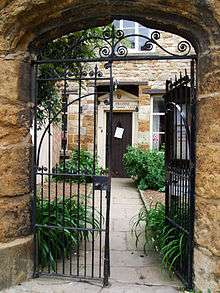Towcester
| Towcester | |
 Old Town Hall |
|
 Towcester |
|
| Population | 9,252 (2011 Census)[1] 8,856 (2001 Census) |
|---|---|
| OS grid reference | SP691481 |
| – London | 65 miles (105 km) |
| Civil parish | Towcester |
| District | South Northamptonshire |
| Shire county | Northamptonshire |
| Region | East Midlands |
| Country | England |
| Sovereign state | United Kingdom |
| Post town | Towcester |
| Postcode district | NN12 |
| Dialling code | 01327 |
| Police | Northamptonshire |
| Fire | Northamptonshire |
| Ambulance | East Midlands |
| EU Parliament | East Midlands |
| UK Parliament | South Northamptonshire |
|
|
Coordinates: 52°08′N 0°59′W / 52.13°N 0.99°W



Towcester (/ˈtoʊstər/ TOE-stər), the Roman town of Lactodorum, is an affluent market town in south Northamptonshire, England.
Etymology
Towcester comes from the Old English Tófe-ceaster.[2] Tófe refers to the River Tove;[3] Bosworth and Toller compare it to the "Scandinavian proper names" Tófi and Tófa.[2] The Old English ceaster comes from the Latin castra ("camp") and was "often applied to places in Britain which had been Roman encampments."[4] Thus, Towcester means "Camp on the (river) Tove."
Location
The town is about 8 miles (12.9 km) south-west of Northampton and about 10 miles (16.1 km) north-west of Milton Keynes, the nearest main towns. Oxford is about 30 miles (48.3 km) south-west via the A43 road, M40 motorway and A34 road. The A43 now bypasses the town to the north but the A5 road still passes through the town centre. This still carries much traffic in the north-south direction which may be bypassed to the west with the possibility of expansion of the town.[5][6]
Demography and expansion
The population was 2,743 at the time of the 1961 Census and this had grown to 8,856 by the 2001 census – a growth rate of about 3% per year. It has since rapidly expanded and there are plans to expand still further[5][6] with another 3,300 houses equating to an appx 8,250 increase in population. With normal growth this could see the total population rise to around 20,000 people by 2020 (based on the current multiplier of 2.5 persons per average household). The expansion will include an A5 north-south bypass west of the town. Improvements to the links to the A43 and Watling Street roundabout took place in the first half of 2015 and including traffic light controls.
Governance
The town has its own Town Council,[7] with limited powers, and is also the administrative headquarters of the South Northamptonshire district council.[8] The town is in the Northamptonshire County Council area.[9]
Towcester used to be within the parliamentary constituency of Daventry. However, since the 2010 general election it forms part of the South Northamptonshire constituency.
Facilities
The town has good shopping facilities with the four major supermarket chains of Waitrose, Tesco, Co-op and Aldi also BM Stores and Poundstretcher have recently opened branches. There is also range of smaller shops and numerous restaurants of various cuisines and national chains such as Costa and McDonalds. All the major banks are present (except HSBC, which closed September 2015,) and Nationwide Building Society are present, as is a main Post Office.
St. Lawrence's Church, Church of England, stands in the middle of the town. It has a 12th-century Norman Transitional ground plan and foundation, probably laid over a Saxon 10th century stone building. Its ecclesiastical heritage may well relate back to Roman times as St Lawrence was patron saint of the Roman Legions. The building was reconstructed in the Perpendicular style 1480–85 when the church tower was added. Permission to quarry stone for this restoration from Whittlebury Forest was granted by Edward IV and later confirmed by Richard III on his way towards Leicestershire and his death at the Battle of Bosworth Field.
The church contains a "Treacle" Bible, a table tomb and cadaver of Archdeacon Sponne, Rector 1422–1448. The Archdeacon started what was thought to be the oldest Grammar school in Northamptonshire, which was merged with the old Secondary Modern School in Towcester to produce Sponne School. It is also claimed[10] that Pope Boniface VIII was a rector of the church before his elevation to the position of Pope. The church tower contains more bells than probably any other parish church in the land: a fine peal of 12 bells and a chime of 9 bells which ring the hours and chime tunes at frequent intervals.
The town has an Air Cadet squadron, 1875 (Towcester) Sqn ATC located near to Sponne School and The 1st Towcester scouts and guides group.
Sport
Towcester is famous for its racecourse, originally part of the Easton Neston estate on the east side of the town. Many important national horse racing events are held there. Greyhound racing is also regularly held at the same venue. In 2010 the World Hovercraft Championship was held on the racecourse with Participants from England, Scotland, Wales, Australia, US, France, Italy, Sweden, Germany, Poland, Belgium, Netherlands, Austria and Slovakia.
Nearby is the Silverstone motor racing circuit, currently home to the British Grand Prix. In fiction the "Saracen's Head Inn" in Towcester features in Charles Dickens's novel The Pickwick Papers as one of Mr Pickwick's stopping places along what is now the A5 trunk road.
Towcester is also home to Towcestrians RFC, a rugby club founded in 1933. Towcestrians play in the Midlands 2 East (South) Division and are affiliated to the RFU, East Midlands Rugby Union and the Northants Rugby Alliance. Towcestrians Mini & Junior Section caters for young players from the ages of 6 up to 17 playing Sundays for both boys and girls Mini & Juniors.
Since 2010, Towcestrians RFC has hosted the Towcester Beer Festival, marrying a festival of guest ales and ciders with rugby and live music. In 2011 the festival took place on 29-30 April, the weekend of the Royal Wedding. In 2012, the festival took place over the first May bank holiday weekend - 4-6 May.
Towcester's cycling club, the A5 Rangers, was founded in 1948 and aims to cater for all aspects of racing, touring, MTB and social events associated with cycling.
History
Prehistoric and Roman periods
Towcester lays claim to being the oldest town in Northamptonshire and possibly, because of the antiquity of recent Iron Age finds in the town, to be one of the oldest continuously inhabited settlements in the country. There is evidence that it was settled by humans since the Mesolithic era (middle stone age). There is also evidence of Iron Age burials in the area.
In Roman Britain, Watling Street, now the A5 road, was built through the area and a garrison town called Lactodurum established on the site of the present-day town. Two candidate sites for the Battle of Watling Street, fought in 61AD, are located close to the town, these are Church Stowe which is located 7 km to the north[11] and Paulerspury which is 5 km to the south.[12] A stone female head, that mixes Celtic and Roman styles, was found on Watling Street outside the town and was given to the British Museum in 1903.[13]
The Saxon period and Medieval age
When the Romans left in the 5th century, the area was settled by Saxons. In the 9th century, the Watling Street became the frontier between the kingdom of Wessex and Danelaw, and thus Towcester became a frontier town . Edward the Elder fortified Towcester in 917. In the 11th century, the Normans built a motte and bailey castle on the site. Bury Mount are the remains of the fortification and is a scheduled Ancient Monument. It was renovated in 2008 with an access ramp added and explanatory plaques added.
Georgian and Victorian periods
In the 18th and early 19th centuries, in the heyday of the stagecoach and the mail coach, Watling Street became a major coaching road between London and Holyhead, and Towcester flourished, becoming a major stopping point. Many coaching inns and stabling facilities were provided for travellers in Towcester, many of which remain.
The coaching trade came to an abrupt halt in September 1838 when the London and Birmingham Railway was opened, which bypassed Towcester and passed through Blisworth, barely four miles away but enough to result in Towcester quickly reverting to being a quiet market town. By 1866 however, Towcester was linked to the national rail network by the first of several routes which came together to form the Stratford and Midland Junction Railway, known as the "SMJ".[14] Eventually, from Towcester railway station it was possible to travel four different ways out of the town: to Blisworth (opened May 1866); to Banbury (opened June 1872); to Stratford-upon-Avon (opened July 1873); and finally Olney (for access to Bedford, opened December 1892). The latter line however was an early casualty, closing to passengers in March 1893 although it continued to be used by race specials up until the outbreak of World War II. The Banbury line closed to passengers in July 1951 and the rest in April 1952. Goods traffic lingered on until final axing in February 1964 as part of the Beeching cuts. The site of Towcester railway station is now a Tesco supermarket.
Towcester might have gained a second station on a branch line of the Great Central Railway from its main line at Brackley to Northampton, but this branch was never built.
20th century and beyond
The motor age brought new life to the town. Although now bypassed by the A43, the A5 trunk traffic still passes directly through the historic market town centre causing traffic jams at some times of the day. The resulting pollution has led to the town centre being designated an Air quality management area.[15] An A5 north-south bypass is likely with plans for expansion of the town being planned by the West Northamptonshire Development Corporation.[16]
Notable people from Towcester
- William James Dawson (1854–1928) clergyman, author, born in the town
- Edward Grubb (1740–1816) stonemason, sculptor; first fine art sculptor to work in Birmingham. Born, Towcester 1740
- James Hutchings Publisher of Hutchings' California Magazine; born in the town
- John Meyrick Agriculturalist, Rower who competed for Great Britain in the 1948 Summer Olympics. Born in Towcester
- Elliot Parish Born in the town 1990 - professional footballer
- Edward Rooker Engraver, draughtsman and actor. Born in Towcester c.1712
- David Sharp (entomologist) FRS born in the town
- Thomas Shepard (1605 - 1649) American Puritan minister
- Graeme Swann (b.24 March 1979) English cricketer
References
- ↑ "Area: Towcester (Parish): Key Figures for 2011 Census: Key Statistics". Neighbourhood Statistics. Office for National Statistics. Retrieved 19 January 2015.
- 1 2 Joseph Bosworth and T. Northcote Toller, "Tófe-ceaster." An Anglo-Saxon Dictionary. Oxford: Oxford UP, 1882. 997. (Online version)
- ↑ Flavell Edmunds. "Towcester." Traces of History in the Names of Places. London: Longmans, Green, and Co., 1869. 272.
- ↑ "Chester." Oxford English Dictionary. oed.com
- 1 2 Northamptonshire Joint Planning Unit – Draft Emerging Core Strategy, pp 9 and 51. NB May be superseded by more recent publication
- 1 2 2011 expansion plans – Pre-Submission Joint Core Strategy, Committee Version, 31 January 2011
- ↑ "Towcester Town Council". Retrieved 5 June 2008.
- ↑ "(SNC)". Retrieved 5 June 2008.
- ↑ "Northamptonshire County Council". Retrieved 6 June 2008.
- ↑ Wilcock, David. "Pope Boniface VIII".
- ↑ http://www.craftpegg.com/Battle_Church_Stowe_CP.pdf
- ↑ Rogers, Byron (2003-10-11). "UK: The original Iron Lady rides again". The Daily Telegraph. London.
- ↑ British Museum Highlights
- ↑ "Stratford and Midland Junction Railway (SMJ)". Retrieved 5 June 2008.
- ↑ "BBC - Northamptonshire - Features: Northants' air pollution".
- ↑ "Sandra Barnes, Leader of South Northants Council, says "This is putting a mark down for future generations and they're not going to thank us for just putting 3,000 houses down" (17 December 2007)". Retrieved 13 October 2008.